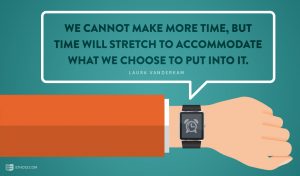I now know the secret to accomplishing my goals each week, thanks to Laura Vanderkam’s Ted Talk on “How to Gain Control of your Free Time.” In under 12 minutes, Laura introduces a way of life presentation with devices like storytelling, calls-to-action, and data to teach her audience the real method to finding more time in a day.
Relatable
Laura opens her talk with a common experience we all share: running late. This is a strong way to open her presentation and spark a connection with her audience right from the top. Her likable personality shines throughout her Ted Talk and she uses real people as examples to show how to utilize free time. Which leads to my next point…
Storytelling
Laura’s short and sweet story about the woman with the broken water heater makes a huge impact on the presentation; it is easy to remember, it is a relatable experience, and it is the most revealing part in Laura’s explanation about finding free time. No one expects to come home to deal with a broken water heater and the mess it leaves behind. No one would plan out the 7 hours it took to get it fixed beforehand. How did the woman with the broken water heater get those extra 7 hours? She prioritized her schedule and put the broken water heater at the top of her list. As a viewer of this Ted Talk, this is a perfect example of how incorporating a story into your presentation can go a long way to leaving an impact on the audience.

Call-to-Action
Laura gives her audience a task to help them find extra time during the week. Make a list of three goals you want to achieve in your career, relationships, and yourself. She then asks the audience to prioritize time for these goals each week. This is an interesting call-to-action because she is not asking for anyone to buy her product or try a service, but she is instead selling a way of life and it is entirely up to the audience member to decide if they want to actively pursue that way of life.
Data
There are 168 hours in a week, and with the time removed for work and sleep, we have about 72 hours each week to fill. Laura uses this data to show that there are opportunities to work on our goals. We quickly lose that time whenever we turn on the TV or stare at our smartphones. By chipping away a few hours each week to do the things we say we want to do, we might actually do them! This data doesn’t come from a scientific study or years of research, it’s just a simple math equation.
Laura’s Ted Talk puts to use some fundamentally successful ways to give an impactful presentation. For more ways to enhance your presentation skills, check out these resources:
How to Kickstart your Productivity: 33 Tips in 140 Characters or Less